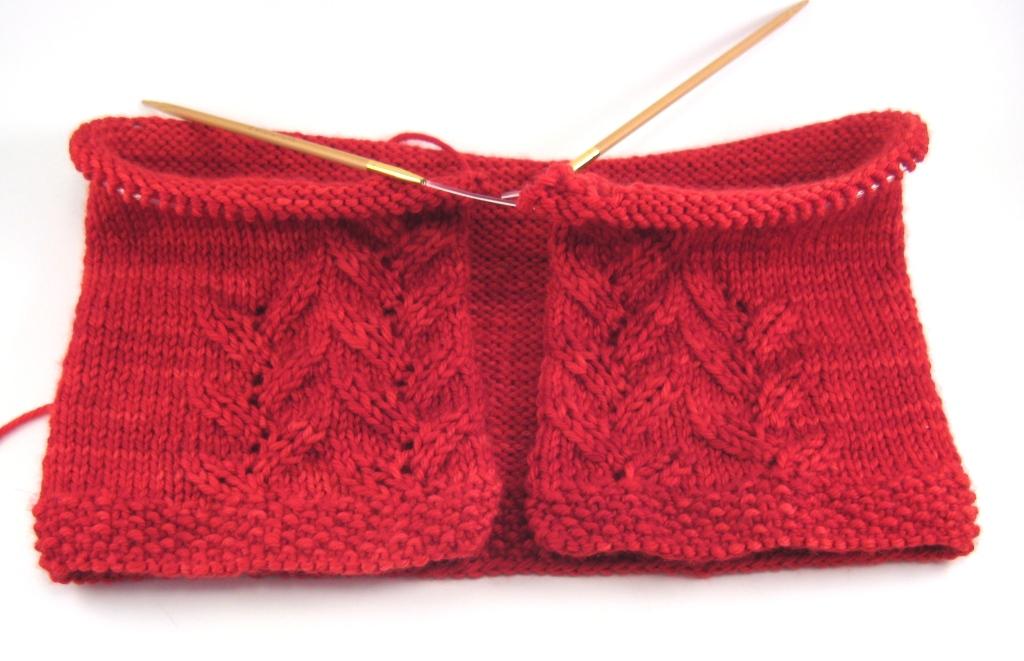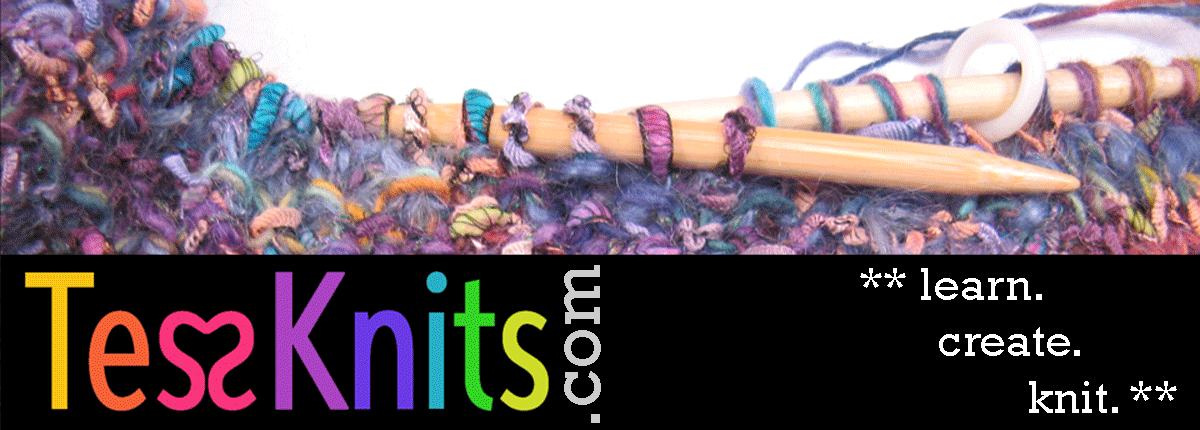OK, so time to start knitting!
Since I’m going to knit the body in one piece, first thing is to add up the number of sts for the back and both fronts. The second size says, 60 sts for the back and 28 apiece for the fronts. Adding those up in my head, plus two edge sts, gives me 120 total.
Wait, what?
I didn’t say I was right, I just said that’s what it gives me. 🙂 I think I managed to add 60 + 28 + 28 + 2 + another 2. But heck, this is a baby cardigan — a couple of extra sts is not going to make a big difference. Which is a good thing, because I didn’t actually figure this out until I was a fair way up the body.
Here is an excellent case of a “mistake” that really, REALLY doesn’t need fixing. It doesn’t affect the stitch pattern; it *might* affect subsequent shaping, so it’s good that we know about it in order to avoid possible confusion later — but it isn’t anything to worry about, and certainly isn’t anything that needs to be ripped back. (Perfectionists may disagree, but I’ll get my cardigan done a lot faster than you will.)
Oh, and one more thing before we really get going — the bottom band is in seed st, and as long as we’re going to go to the trouble of making our lace chart properly symmetrical, why not make the seed st the same? A tiny detail, but what the heck. Add one more st to the total, then, to get seed st rows that begin and end with the same kind of st — 121 sts for me, but that’s with my bad math. Here is the correct breakdown:
- (1 extra edge st) + 28 sts (left front) + 60 sts (back) + 28 sts (right front) + (1 extra edge st) = 118 sts.
- The extra edge sts are added in so I can slip the first one, and knit the last one, without interfering with anything else that may be going on. If you aren’t familiar with using edge sts, or selvedges, take a look here for more info.
- Then add the single extra st to make the seed stitch come out right — for a total of 119 sts.
- This extra st can be decreased out when we start the stockinette part, or just added to the back sts and left alone. One extra st (or 3!) won’t make much of a difference here.
CAST. ON. whoo-hoo! and work 1″ of seed st that is now nicely symmetrical. Be sure to work your selvedge technique on the edges.
I’ll confess right now that I probably picked the wrong one for myself, because I kind of didn’t think about having to pick up the button bands later on, and I used my old favorite slipped selvedge, as I referred to up there. This means I’ll only have one edge st for every two rows and that will make it a bit harder to pick up sts neatly. You should probably use the knitted selvedge or the garter selvedge so you will have plenty of sts for picking up later.
While you’re doing that, take a look at how much space they waste giving you “two different ways” to make seed stitch — one for even numbers of sts, one for odd numbers of sts. If you were explaining to someone how to paint the squares on a black and white checkerboard, you wouldn’t do it this way. You’d say something like, OK, paint the first row of squares black and white, alternating. Then turn around, look at the square below the square you’re about to paint, and paint this square the opposite color. This is the sane way to do seed stitch.
And, technically that is what they do, even, with row 2 — where they say “knit the purl sts and purl the knit sts as they face you” — or as the French like to say, comme elles se présentent, or “as they present themselves”.
The only “difference” here is in the setup row. The way they write it out is so goofy, it gives us a clue: this pattern was probably generated from software, rather than being written by a person, so we ought to keep that in mind as we go along as well.
OK, when the seed stitch is done, we go into the lace pattern. I placed st markers to set off two groups of 10 sts on either end of the row, which are going to be our two fronts. Then I started working the FIRST row of the lace chart on one end, and the FIFTH row of the lace chart on the other end. This is what is going to give me my proper mirror image of the lace pattern.
Since the wrong-side rows also include lace: it is important to remember which end of your knitting is which, and remember also that everything flips — so be sure that on the next row, you work the SIXTH row of the chart at THIS end of the row, and the SECOND row of the chart at THAT end. After a while, and a couple of near misses, I had to write it down like this, and put a check mark each time I finished a row. The picture area of the pattern seemed like a handy place to do this. (Please pardon the big white streak down the middle which was caused, I suspect, by my dusty scanner.)
In case you want to do the same thing, here it is written out to copy and paste for your own use.
Row 1 / Row 5 (RS)
Row 6 / Row 2 (WS)
Row 3 / Row 7
Row 8 / Row 4
Row 5 / Row 1
Row 2 / Row 6
Row 7 / Row 3
Row 4 / Row 8
After a total of 3 repeats (24 rows), I stopped doing the lace on one set of sts at either end. This is the set that is further in from the ends of the rows, and ends up closer to the armpits when the sweater is properly folded.
I continued the lace pattern on the “outside” sets of sts for 2 more repeats, to give me my column of 5 repeats near the button band edges, and a column of 3 repeats on either side of those.
 Unfortunately in this picture, that 5th repeat gets rolled over to the right side, so you can really only make out 4 repeats on the taller columns. But trust me, it’s there!
Unfortunately in this picture, that 5th repeat gets rolled over to the right side, so you can really only make out 4 repeats on the taller columns. But trust me, it’s there!
Now work even up to the armholes, which for this size it says 7″ from the beginning. I’m getting just about 8 rows to the inch exactly. Since we have 1″ of seed st already, and 40 rows’ worth in the lace which is 5 additional inches, I only need about 1 more inch, or 8 more rows, until I’m there.

5 comments for “Provence Baby Cardigan, Part 2 – getting started, edge stitches, lace pattern”